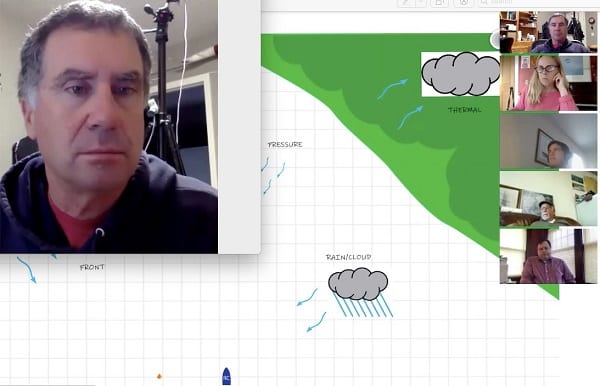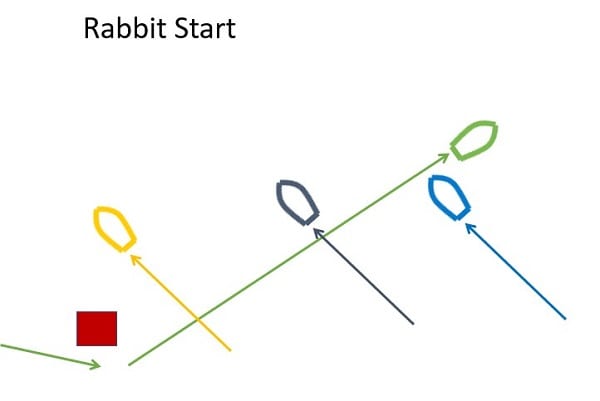By Mike Ingham
With the sudden change in all our lives, the choice was either pause sailing until things cleared up or figure out how to stay engaged. I suppose it really should not be a surprise that so many sailors chose the latter. I have been part of this adaptation and it is interesting how we have all evolved. The first phase was switching to online, and eventually we figured out how to get on the water, either short-handed or downsizing boats. Cautiously we have started racing, mostly locally as there are not many regattas out there. We as sailors are often ‘cutting wood’, rushing from regatta to regatta and do not spend much time on advanced education. Perhaps the positive in all this is an opportunity to step back and ‘sharpen the saw’?
Online Seminars:
The very first week I got home from my winter circuit that was cut short, there were plenty of one-hour complementary online seminars from industry professionals. Though they have since tapered, they are still valid. For example, US Sailing’s “Starboard Portal” series is still in full swing and, just this week, I did a Thistle online seminar for North Sails on heavy air speed as part of their ongoing commitment to online learning. About 75 people tuned in, so seminars are clearly still in demand. These are a bit of “hit or miss” on the quality of material and presenters but by choosing wisely, you can definitely get something out of them.
Online Courses:
For my part, I had a few good clients for my coaching services that suggested we switch from live to online. We were already planning in-person sessions, so it was not a big leap to pivot and change our venue to Zoom. One thing led to another and before I knew it, I was filling up a series of mini university-style courses in subjects like speed, tactics, rules and starts. Each course is in-depth learning: four weeks, two hours a week, with each week building from the week before. The idea is to coach a process for each subject, for example a tactical process, as opposed to situations. I figure situations can be built on a process, but with no process, there is no way to map those situations onto anything including a racecourse! It has been fun and a great way to get back to the fundamentals that we normally are too rushed to address. Unlike the online seminars, the courses are limited significantly in size to keep them personal and interactive.
Throughout all this, we cannot forget we are a social bunch, so I host a Happy Hour and that has proved to be popular. We miss our friends, if you cannot be with them in person, Zoom is the next best thing!
The next phase: Sailing.
Practicing on your own is not easy. One of my online clients said that when he goes out in his J/70, they can sail with three onboard but not with other boats. I am not sure how they came up with those rules (the rules are so different wherever we go), but those are the rules from his club. He wants to practice, but all his team wants to do is sail upwind so they can plane downwind. Cannot blame them. Planing is fun, but he asked what to do to make the sailing time more productive. So, I helped him come up with a curriculum. I check in weekly to see how things are going and that helps keep his team on track. We have a specific briefing before practice (or their race) and we review their GoPro video every Wednesday on Zoom. I think just sailing around is fun, and that is okay if that is what you want to do, but if you want to progress, you should have a plan.
We are working together to create and move forward with his plan, but you can do this without outside virtual help too. Here is a typical week’s plan that we came up with for him as part of a five-week program. You could do something similar or modified to meet your needs. We focus heavily on boat handling because it is hard to gauge speed when sailing by yourself.
Week One: Tacks and Gybes
- Set a windward and leeward mark to serve as a boundary (to help herd cats), enough room for 20 tacks, tacking every 30 seconds or so.
- Tacks
-
- GoPro (quantity – two)
-
- 1st at back of the boat aimed at driver so you can see the tiller and main sheet
- 2nd on back of the boat aimed at trimmer
-
- Do 10 tacks, one about every 30 seconds, stop and talk about it.
- Do 10 more, again stop, and reflect.
- GoPro (quantity – two)
-
- Gybes
-
- GoPro (quantity – two)
-
- One on bow looking back at bow person (take the one that was aimed at the driver)
- 2nd aimed at trimmer (this one can stay where it was)
-
- Set spinnaker casually around weather mark. (we are not working on sets today)
- Do gybes every 30 seconds until halfway to the leeward mark.
-
- Stop and talk
-
- Do gybes every 30 seconds until at the leeward mark.
-
- Stop again and talk
-
- GoPro (quantity – two)
-
- Repeat both the tack and the gybe sequence.
- Debrief
-
- Assign someone on the team to edit out three good tacks and three gybes from both cameras (so that will be 12 total video clips).
-
- These clips will typically be from later in the day/training session as you figure things out.
-
- Pick a day to have a Zoom call with the entire team for a one-hour review.
-
- Keep the debrief to 45 min.
- Spend 15 minutes talking about what to work on the next week
-
- Assign someone on the team to edit out three good tacks and three gybes from both cameras (so that will be 12 total video clips).
-
Week Two: Sets and douses (without all the detail)
- Set marks far enough apart so can settle into the run, but not for too long!
- Video (x2) set up to see bow person, and trimmer
-
- Then switch from trimmer to driver
-
- Series of sets and douses
Week Three: Roles and communication
- Roles and communication on the boat
-
- Upwind
- Downwind
-
- Debrief is a spreadsheet of roles and communication
Week Four: Boat speed up and down wind
- No marks
- Sail upwind for a long way, experimenting with trim, heel etc.
- Sail downwind concentrating on angles and speed
-
- Communication with the driver and trimmer
-
- Debrief is spreadsheet of communication and roles for speed
Week Five
- Starts – Defining a pattern
- Starts – Roles and communication for the starts
The idea is to sail a short 1:30 to 2:00 session that is totally focused on the defined practice topic of the day, then if you want to plane around because it is windy, go ahead!
Once the five-week session is complete, come up with another five weeks of topics based on what you have learned from the first five weeks. Figure out what you need to work on next. You can even repeat something because it is important and needs some more work to refine processes.
For some clients, we added a Zoom briefing on the boat before a practice or race on the weekend. After sailing, the team uploads the video to Google Drive, I review and edit, then run the debrief mid-week. The advantage of this process (besides another set of eyes on the video and technique being filmed) is that it really motivates the team to stay on task. They tend to be fully engaged because they know someone is watching!
If you are lucky enough to be able to sail with others, but with no formal racing, try using rabbit starts – I am a big fan of them. With rabbit starts being a starting technique commonly used by the 505 class through the World Championship level, they are a great way to get some racing in without a need for any Race Committee. I did this all spring while training on my Sunfish in Rochester along with some friends. We would do our tacking or whatever drills we chose, then end the day with five or so short rabbit start races. We took turns being the rabbit. We set a two-mark course, and the rabbit would round the leeward mark to port to get things started. The other boats simply duck the rabbit and the race is off and running!
No matter what route you take, I think efficient training is important. Just going sailing is fun but if you want to learn, you need to be focused on learning and use your practice time wisely. I do think that, in many ways, our isolation situation is an opportunity to take a step back and get back to fundamentals.
Some of these new training methods will continue to be used even when we get back to ‘normal’. Online courses and coaching are proving more effective than I ever would have imagined, so I can see a hybrid model of live and virtual coaching that will work well even in the best of times. These new tools that help us learn are here to stay.
About the Author: Mike Ingham
Mike Ingham works for North Sails One Design, is a Racing Editor at Sailing World magazine, and a professional coach. He was named Coach of the Year by US Sailing for his 2016 coaching of the USA Sonar Paralympic Team to a World Championship and a Silver Medal in the Rio Games. Most recently he has been running in-depth online courses and virtual coaching.


